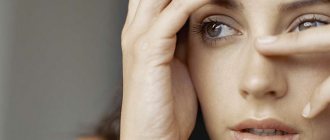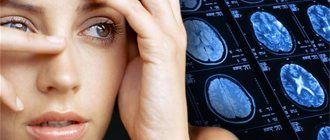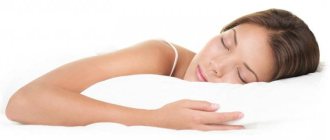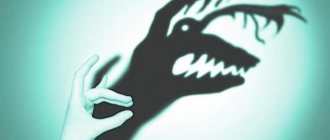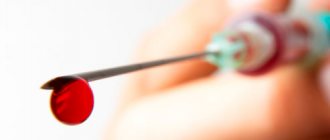At home, attacks of erythrophobia can only be stopped using an integrated approach. It is necessary to simultaneously use classical medicine, folk recipes and methods of psychological influence.
Erythrophobia is not a clinical pathological condition, but it greatly annoys a person, affecting the level of his social and personal life. We can talk about obsessive syndrome, in which the face turns red from the slightest excitement or worry. A sense of self-confidence is lost, isolation and a desire to limit any social contacts appear.
And yet this syndrome can be treated quite easily at home. For this purpose, both classical medicines and folk remedies and recipes are used. Almost every person has personally experienced situations when his face quickly and suddenly turned red. Excitement causes blood to rush to the tissues, the heartbeat quickens, and emotional intensity is at its peak.
The rush of blood is captured quite clearly in the photo below.
Chronic insecurity and physiological dependence
Regardless of the fact that an attack can happen to anyone, there are people for whom erythrophobia becomes a “curse” for life. Their faces suddenly begin to turn red from puberty, and at an older age this pathology leaves its mark on all aspects of the patient’s social life.
Erythrophobia, in fact, is expressed not only in the redness of the face, but also in the very fear of appearing in front of an opponent in such an unsightly form. The chronic form of the pathology leads to depression, neuroses and emotional depression. Therefore, the disease is classified as a psychosocial problem with characteristic physiological symptoms and signs. Redness is caused by a rapid flow of blood to the superficial conducting vessels of the dermis.
Causes
There is no definite answer to this question, even though the mechanism of the phenomenon itself has been fully studied. Experts identify several reasons that are definitely associated with the appearance of erythrophobia in humans.
- It's all due to the nervous system. The human brain is able to control its actions thanks to the somatic and autonomic nervous system. The first is responsible for a person’s voluntary actions, which he fully controls, and the second is responsible for the work of internal organs, which occurs involuntarily. The appearance of redness on a person’s face is directly related to blood vessels, which in turn expand under the influence of the autonomic system. Only one thing remains unknown: why the autonomic nervous system of a person with erythrophobia causes the blood vessels to dilate without a necessary reason.
- Everything hidden becomes clear. For some, a red face appears in awkward situations in which a person is trying to hide something or deceive someone. Gradually, the body develops a dependence on a psychological level, which determines the relationship between a person’s ability to blush and external circumstances. A sick person voluntarily limits himself in social activities, for example, refuses a high position, changes jobs, or avoids relationships with the opposite sex. Thus, the physiological reaction leads to serious consequences.
- Childhood manifestations in adults. Another reason related to the emergence of erythrophobia, scientists identify a problem of a psychological nature, the roots of which go deep into childhood. It is believed that in childhood such a person was distinguished by modesty and shyness, was deprived of encouragement from parents or teachers, which is why he acquired a number of complexes that predisposed him to erythrophobia.
Treatment of erythrophobia using traditional medicine
Official medicine does not classify erythrophobia as a disease. Because the problem has not a physiological, but a psychosocial basis. You can solve it with the help of psychotherapists, psychologists or a neurologist-vegetologist. And after completing the full course of therapy, start taking vitamin complexes:
- Vitamin K – helps reduce vascular permeability and strengthen vascular walls.
- Vitamin C – constricts blood vessels, has an anti-edematous effect, strengthens the vascular wall.
- Vitamin P – helps to cope with capillary fragility, strengthens blood vessels.
Traditional medicine in its recipes suggests using medicinal plants such as hawthorn and rose hips, horse chestnut and arnica extracts in the treatment of erythrophobia. If you have hot flashes, you should not take hot baths or cleanse your face with steam. You should refrain from using hot compresses and intense massage. Unfortunately, cold compresses do not give a noticeable result and do not help relieve redness of the facial skin.
Only comprehensive measures can help, otherwise this problem cannot be solved. You will need to consult with specialized specialists, regularly protect your facial skin from the negative effects of the external environment, adhere to a proper nutrition system and lead a healthy lifestyle.
Treatment of mysophobia
Modern medicine offers many effective methods to solve this problem.
- Treatment of mysophobia with medications.
Drug treatment of fear of pollution and infection is used only as an auxiliary method to relieve severe symptoms of the disorder. Using medications without psychological work on the problem will not help get rid of the phobia completely. As a rule, a qualified specialist prescribes a course of antidepressants. Additionally, neuroleptics and sedatives may be prescribed. The drugs effectively relieve severe symptoms. However, their use is recommended to be combined with psychotherapy and psychological training. Otherwise, symptoms quickly return after stopping the drugs.
- Using the cognitive behavioral method of psychotherapy.
The method of the famous psychotherapist J. Schwartz called “4 steps” works most effectively in the case of mysophobia. The technique includes the following steps:
Let's call a spade a spade: it is important to realize that it is not the infection that forces you to wash your hands and wipe off every speck of dust, but your anxiety disorder. We are looking for the reason: what exactly causes fear. (write the list on a piece of paper) Changing the object of fixation of consciousness: distract yourself with bright, interesting events
You need to find new hobbies, do important and interesting things, get creative, and go on a trip. Look at the problem objectively, change or eliminate unnecessary attitudes, a negative view of what is happening.
Mysophobia is also successfully treated by hypnosis: from the subconscious, with the help of suggestion, the psychotherapist removes negative, destructive attitudes, forms a calm and loyal attitude towards the object of the phobia.
The method of paradoxical intention, developed by V. Frankl, also works effectively in the fight against mysophobia. It involves intentionally confronting the object of your phobia and working to consciously manage your fear.
Traditional medicine recipes
Any treatment for facial redness in a folk recipe comes down to the use of external remedies in the form of compresses or lotions, as well as rubbing and taking soothing tinctures:
- You need to take 2 dessert spoons of burnet root, pour a glass of boiling water over them and leave for about half an hour. Use as a means for warm compresses, each of which should be kept on the face for no more than an hour.
- Grind oak bark, take one spoon of raw material and add it to 500 ml of water. Boil everything together for 10 minutes over moderate heat and then apply as compresses.
- Oak bark can be replaced with freshly brewed and strong infusion of high-quality black tea.
- In the morning, you need to completely wipe your body with cool water with the addition of table salt. For 1 liter of water – 1 teaspoon of crystals.
- You should regularly take a contrast shower, which will allow the skin to adapt to temperature changes and stop reacting with redness to changing climatic conditions.
- A decoction made from the green parts of peppermint is used to rinse the body before going to bed. 1 dessert spoon of fresh mint leaves is brewed with a glass of boiling water, infused for 15 minutes and the entire volume is diluted in 5 liters of warm water prepared for washing.
- It is recommended to drink mint tea as a natural sedative: half a cup twice a day.
Principles of treatment
Pharmaceuticals, folk remedies, surgery and psychotherapy help overcome the disease. The first three methods get rid of external signs, and therapy will get rid of the underlying causes.
Psychotherapy will not get rid of the external signs of a phobia, but it will help you better control yourself and react less sharply to conflicts. Treatment uses cognitive behavioral therapy. It makes it possible to change the course of thoughts and get rid of the most destructive ones. Relaxing techniques - breathing and muscle relaxation - will be added. Auto-training increases self-confidence. You can practice them on your own.
Medicines help fight anxiety and block reflex vasodilation that leads to redness. The use of drugs is strictly limited, because their long-term use leads to addiction and the development of serious side effects. The course begins only after consultation with a doctor. Self-medication can lead to the development of symptoms of dystonia.
Folk remedies
Such methods help relieve nervous tension and redness. At home, you can take herbal decoctions and apply compresses. To help solve the problem:
- Pouring. They are worth starting every day with. The water temperature is slowly reduced. In the evenings, a contrast shower will be an excellent solution.
- Compresses. They will require brewed green tea (without additives). It should be cooled to room temperature, applied to cotton pads and applied to the face area at least twice a day. Green tea can be replaced with lightly salted water or chamomile tincture.
- Mint decoction. One tablespoon of crushed leaves is poured into a glass of boiling water and kept in a water bath for 10-15 minutes. Drink ½ glass before meals.
Features of surgical interventions
This method of treatment also has side effects. We are talking about compensatory sweating, lowering blood pressure and a negative reaction to stress. The probability of relapse after surgery does not exceed 10%.
Drug therapy: what medications can be taken at home
This category includes all groups of drugs used by doctors to treat all common types of phobias:
- sedatives;
- antidepressants;
- substances that can block the excitability of the sympathetic nervous system;
- beta and alpha blockers;
- sympatholytics.
Beta blockers are needed to suppress the heart rate, which will help lower the heart rate. Its frequency is the main provocateur of the further process of excitation throughout the body. An alpha blocker helps reduce the reactivity of blood vessel walls, stabilizes the diameter of the vascular lumen and prevents intense filling with blood.
But treatment with these drugs is effective only for the classic type of erythrophobia, when redness affects the entire area of the face. If the hot flashes are local, when a change in color is recorded only in a certain area of the skin, then the cause of this condition may not be at all psycho-emotional and a more thorough examination is required.
How to get rid
Experts do not recommend treatment and advise contacting a psychologist at the first sign of phobia. To get rid of redness as such, you can seek medical help; this can be treated surgically. However, most people learn to live in peace with their peculiarity if they undergo psychotherapy.
Psychologist's advice
First of all, you need to undergo a full medical examination to rule out medical reasons. Consultation with an endocrinologist, dermatologist, gynecologist, or therapist is necessary. If there are no medical prerequisites, and the redness is caused solely by psychological reasons, then only psychotherapy will be needed.
The goal of psychotherapy is to convince the client that the redness increases due to anticipation, anxiety, and stress that the person creates for himself. In this regard, the main work is aimed not so much at working through psychotrauma, but at mastering relaxation and self-regulation techniques. A person must feel his body, learn to control his reactions, and remain calm. At the same time, the specialist changes the client’s attitude towards his particularity. You need to form the attitude that this is not shameful, you don’t need to be ashamed of it.
Psychotherapy does not eliminate the physiological cause of redness; it changes a person’s attitude towards his peculiarity. The patient's self-esteem increases, it becomes easier for him to communicate with people, and the frequency and intensity of attacks decreases.
It is important! To correct negative attitudes, psychotherapy methods such as cognitive behavioral psychotherapy, individual and group psychotherapy, hypnosis, and gradual immersion in stressful situations are used. In case of a complicated course of the phobia, antidepressants, tranquilizers, and sedatives are prescribed.
Surgery
For medical correction of erythrophobia, sympathectomy is used. The effectiveness of sympathectomy for erythrophobia reaches 94–97% with a tendency to complete redness and 50% with a tendency to spotty redness. Using special technology, doctors penetrate inside the sympathetic trunk and block the areas responsible for transmitting nerve impulses that cause redness.
It is important! The operation has a number of contraindications and side effects. You must first consult a doctor and undergo a full medical examination.
Independent struggle with phobia
It is impossible to cope with a phobia on your own. You can only learn not to aggravate the redness with the help of breathing exercises, auto-training and other relaxation methods. But it will not be possible to completely get rid of bouts of redness, if this is a characteristic of the body.
How to get rid of erythrophobia yourself:
- In stressful situations, for example, before speaking in public, use breathing exercises. Take five slow deep breaths and five slow deep breaths. Concentrate on breathing and counting.
- Get enough sleep and meditate before bed. Releasing thoughts and restful, restful sleep restores the nervous system, reduces its excitability, which reduces the frequency of redness.
- Learn the practice of yogic sleep. This is a special technique aimed at reducing mental stress.
- Use auto-training and affirmations. On your own or with the help of a psychologist, make a list of phrases for self-hypnosis that are suitable for you.
What methods can you treat erythrophobia yourself?
There is no single classification of the causes of erythrophobia, therefore treatment can only be purely symptomatic. Traditional recipes allow you to choose an individual way to relieve a psycho-emotional outburst, but the use of such remedies must certainly be discussed with the attending physician.
There are many ways to get rid of this disease. In some cases, the patient has to use medications, but in most situations the problem can be smoothed out simply by using proven home remedies. Taking medications will definitely affect the entire body, so it is better to choose a different path - turn to relaxation methods:
- auto-training classes;
- visualization methods;
- meditative practices;
- self-hypnosis.
Such activities have a specific goal: it is necessary to develop a sense of self-confidence, raise self-esteem, and try to reduce the body’s physical reaction in response to an unusual situation. This is the only way to prevent panic attacks. All these techniques can be used independently, but to speed up the result and consolidate it, it is still better to contact specialized specialists.
Methods that help get rid of blushing
The first way is to relax the facial muscles. As soon as you feel that the tide is coming, try to relax the muscles of your neck and shoulders. Smiling is the best way to hide your shortcomings
When smiling, almost all people's cheeks turn red. Blink and take a couple of deep breaths, focusing on your breathing. Practice this method at home, then it will become easier for you to say no to phobias and fears in public
Accept yourself as you are. Keep a cool mind in any situation. Do not wear clothes that restrict movement or cause excessive sweating. Expand your horizons and vocabulary, try to be less nervous. Many of us are afraid of blushing when we have nothing to say in response to our interlocutor. During stress during a conversation, many people begin to forget the right words, and then awkwardness arises.
Psycho-emotional correction as a way to eliminate erythrophobia
In addition to all of the above, it is recommended to turn to psychotherapy methods. The specialist will suggest the correct techniques, which can then be used at home. Such influence helps to identify the true causes of the phobia, simplifies the individual’s attitude towards specific reactions of the body and increases the level of confidence in critical situations. If independent practice does not bring the expected result, then you can resort to deep hypnosis with the participation of an experienced psychotherapist.
The effectiveness of this approach is prolonged over time and quite stable. However, there are always certain risks that affect the level of psychological defense, and therefore the phobia sometimes returns again. The main rule of such therapy is constant control of one’s own emotions. Successfully overcoming several stressful situations will gradually lead to consolidation of a positive result at the physiological level. Each time the redness will become weaker, and the consciousness will no longer react so painfully to this fact.
Treatment
Despite the fact that fear of heights is necessary for self-preservation and survival in any difficult conditions. Excellent results are achieved by gradually getting used to the height. Such therapy should begin at a height that is as comfortable as possible for the patient. Sometimes close relatives are involved in therapy to support the patient.
Good results can be achieved through visualization. To overcome the fear of heights, a person must constantly imagine himself at a height and gradually move from fantasies to actions.
Using special psychological techniques, you should learn to relax and block the feeling of fear.
In severe cases, cognitive-behavioral methods are used, based on teaching the patient self-control of mental and physical consciousness. In this case, fear is blocked at the hormonal level.
Sometimes the patient may need to be given sedatives to stabilize the condition.
What happens if erythrophobia is not treated?
With regular manifestations of erythrophobia, individual patients often become victims of their psychological complexes, which leads to undesirable consequences, worsens the quality of social life and the ability to adapt to society:
- Both men and women can feel insecure and inferior, especially if they begin to compare themselves to other people.
- A person is on the verge of completely refusing to overcome life’s difficulties, the desire to move forward and self-development is lost.
- One’s own opinion is no longer expressed even when the patient is completely confident that he is right.
- Low-skilled professions are chosen that do not require constant contact with visiting people or colleagues. All extraneous social connections cease in their infancy.
- A person is in a state of constant dissatisfaction, as he does not have the opportunity to implement the accumulated knowledge and skills. The scope of application of skills is reduced only to professional interests.
- An offer to advance up the career ladder is perceived as a negative promise.
- New social phobias develop, which lead to a complete refusal of contact with other people. A person is constantly in a state of stress, he is diagnosed with autonomic neuroses and other severe somatic disorders.
- In particularly advanced situations, a feeling of doom arises and the patient begins to incline toward suicidal thoughts.
The disease has a synonym - ereutophobia, characterized by anxiety in people with a fear of redness in the face. The following terms can also be considered synonymous: blushing syndrome, stress redness, stress hyperemia, stress erythema.
With the right approach, erythrophobia will recede, and all attacks that have happened to a person previously will be considered only as a life experience. Constant diligence and the ability to extinguish the psycho-emotional reactions of your own body help to achieve a sustainable withdrawal effect.
How to overcome this phobia
Any case of fear of doctors is individual and requires specific treatment. It is possible to get rid of jatrophobia only by finding the cause. If you analyze your inner sensations, thoughts, feelings, then this can be done by the person himself. But if, when remembering the doctor, panic and hysteria begin, it is very difficult to calm down, then the help of a psychologist is needed. To avoid visiting the hospital, it is better to go to a private clinic or call a doctor at home.
If you decide to seek help from any medical institution, then take with you a person with whom you will feel at ease and calm. He will support and understand in difficult times for you.
How not to confuse the phobia of fear of doctors with ordinary fear
A striking example and portrait of a jatrophobe - he is very actively interested in treatment with folk remedies and methods of alternative medicine. All this is explained by the fact that he believes more in some grandmother’s healer, who can cure him using a photograph or simply by preparing some special decoction. This is simple self-deception.
There are cases in the practice of doctors when jatrophobia was passed on from generation to generation.
The reason why children are afraid of doctors
Or as it is also called by professionals, iatrophobia lies largely in the behavior of the parents, since the child copies this fear from adults.
He remembers their every word and expression. When they talk about how they hurt in the hospital, how dangerous and scary it is.
It is also worth taking into account the individual characteristics of the baby; some children do not like tactile communication; any touch from strangers is at least unpleasant for them. Perhaps the child has a low pain threshold and no matter what is done in any medical institution during various procedures, it causes pain for him. With such children, even after one unsuccessful visit to the clinic, it is difficult to persuade them to just go there.
In most cases, the adults with whom the child lives are to blame for jatrophobia in children. If a mother and her child behave insecurely and too emotionally when visiting the hospital, then the child feels the same way. This is where his panic and hysteria arise.
Symptoms
The main complaint is frequent, uniform redness of the face or the appearance of red spots on the face (“geographical hyperemia”). Redness of the neck and décolleté area is also possible. In some patients with erythrophobia, hyperemia is accompanied by a feeling of heat. Redness of the face and upper body causes feelings of inferiority. Patients suffering from erythrophobia lose self-confidence, limit their social life, choose professions that do not require contact with other people, and experience difficulties in building close relationships. The impossibility of full professional, social and personal fulfillment with erythrophobia can provoke social phobia, depression and thoughts of suicide.
Medicines for erythrophobia
Medicines are aimed at combating anxiety, blocking reflex vasodilatation and facial redness. The use of medications is limited because some are addictive or have serious side effects. What medications are used to combat facial redness:
- Beta-adrenergic blockers (beta blockers). They reduce heart rate and blood pressure. The drugs help suppress an attack of skin redness.
- Alpha1-adrenergic receptor blockers. The action of the drugs is aimed at reducing vascular contractility.
- Drugs that inhibit the uptake of serotonin into tissues.
- Tranquilizers. They normalize autonomic disorders and help cope with fear. The active ingredients of most tranquilizers are benzodiazepines. Tablets are addictive and therefore not suitable for long-term use.
The listed medications can only be taken after consulting a doctor. Self-medication can lead to the development of symptoms of dystonia.
Medicines for phobias are prescribed exclusively by a doctor
What is pathology
Before concluding that there is erythrophobia provoked by blushing, you need to realize that redness of the skin of the face as a result of a reaction to social stimuli is a natural process for most people. This process is due to the release of nervous tension that accumulates inside. Blood quickly flows to the superficial capillaries of the dermis, which visually manifests itself as redness. There are people who blush at the mere glance of not only strangers, but also loved ones.
Erythrophobia can haunt a person from the moment of puberty until the end of life, aggravating a person’s relationships in society if he does not learn to deal with it.
The phobia is the fear of blushing. The worst thing for a patient is to look unsightly in front of his interlocutor. Over the years, the fear of blushing can lead to prolonged depression, neurasthenia, and depression.
The disease is classified as a psychosocial problem with inherent physiological signs and symptoms. Erythrophobia must be dealt with in complex ways, which include working with a psychologist, home treatment and drug therapy.
Fear of blushing - blushing syndrome in public
Brief anatomical background and pathogenesis
When blood suddenly rushes into the dilated vessels of the subcutaneous tissue of the face, it turns red. This phenomenon is called blushing syndrome. Facial hyperemia occurs during physical activity, emotional stress (joy, shame, fear, etc.). Redness appears throughout the face evenly or in separate spots. Most often the cheeks turn red.
Erythrophobia is caused by facial hyperemia, and facial hyperemia is caused by erythrophobia. A vicious circle is formed. When a person is afraid of blushing in public, adrenaline is released. This neurotransmitter stimulates the sympathetic nervous system, increasing heart rate. The blood supply to the vessels improves, the face turns red. The fear of blushing in public is caused by serious psychological problems. Without finding out the underlying reasons, it is very difficult to get rid of fear.


